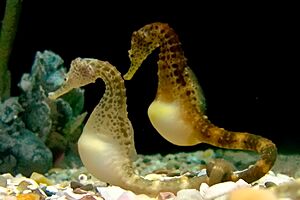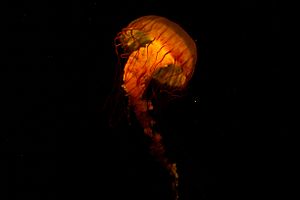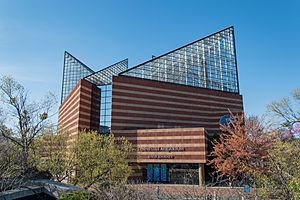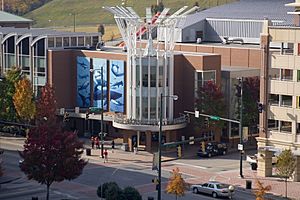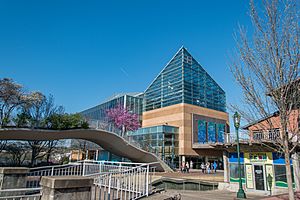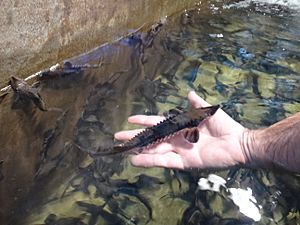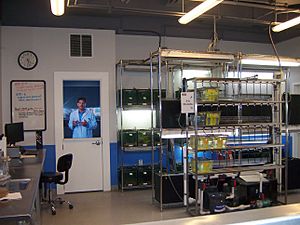Tennessee Aquarium facts for kids
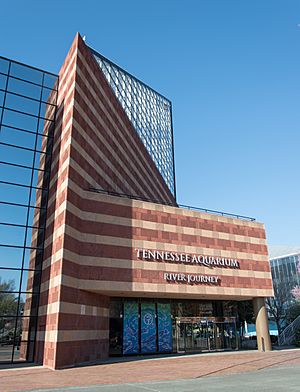
River Journey Building
|
|
| Date opened | May 1, 1992 (River Journey Building) April 29, 2005 (Ocean Journey Building) |
|---|---|
| Location | Chattanooga, Tennessee, United States |
| Coordinates | 35°03′21″N 85°18′39″W / 35.0557°N 85.3108°W |
| No. of animals | 12,000 |
| No. of species | 795 (as of 2013) |
| Volume of largest tank | 618,000 US gal (2,340,000 L) |
| Total volume of tanks | 1,100,000 US gal (4,200,000 L) |
| Memberships | AZA |
The Tennessee Aquarium is a super cool place in Chattanooga, Tennessee, where you can see amazing aquatic animals. It's a non-profit organization, which means it focuses on education and conservation, not just making money.
The aquarium first opened its doors in 1992 right by the Tennessee River. Later, in 2005, it got even bigger with a new expansion. It's like two giant buildings filled with water wonders!
Since 1993, the Tennessee Aquarium has been approved by the Association of Zoos and Aquariums (AZA). This means it meets high standards for animal care. It's home to over 12,000 animals from nearly 800 different species. Imagine all those creatures!
Millions of people have visited this awesome aquarium. It's often called one of the best aquariums in the whole country.
Contents
Explore the Aquarium's Amazing Exhibits
The Tennessee Aquarium has two main buildings full of exhibits. The first one is called River Journey, which opened in 1992. The second is Ocean Journey, added in 2005. They are right next to each other!
River Journey: From Mountains to the Sea
The River Journey building is huge, about the size of a twelve-story building! It holds over 400,000 gallons of water. When it first opened, it was the biggest freshwater aquarium in the world.
This building tells the "Story of the River." You follow the journey of a raindrop from the high Appalachian Mountains all the way to the Gulf of Mexico. About two-thirds of the exhibits show this journey. The rest feature cool aquatic animals from all over the globe.
Here are some of the main exhibits you'll find in River Journey:
- Appalachian Cove Forest: This area features River Otter Falls, which opened in 2014. You can watch playful North American river otters. You'll also see free-flying song birds and native fish like shiners and trout. There's even a waterfall that drops into a 30,000-gallon mountain sink.
- Delta Country: This exhibit shows animals from the Mississippi River delta. Its main attraction is Alligator Bayou, which opened in 2015. Here you can see young American alligators and alligator snapping turtles.
- Rivers of the World: This gallery has many aquariums with animals from famous rivers. You can see creatures from the Amazon River, Congo (Zaire) River, and Fly River. This is also where Miguel Wattson, the aquarium's electric eel, lives! Miguel "talks" to the public on Twitter by sending out tweets when he zaps. In 2019, his electricity even powered a Christmas tree!
- Tennessee River: This gallery shows off species found right in the Tennessee River valley. The biggest tank, holding 145,000 gallons, represents Nickajack Lake. You can see fish like the American paddlefish and channel catfish here.
- River Giants: Get ready to see some truly enormous freshwater fish from around the world! This section features alligator gar, arapaima, giant pangasius, and redtail catfish.
River Journey also has many different turtles, seahorses, and frogs.
Ocean Journey: Into the Deep Blue Sea
Ocean Journey opened in 2005 and is also very tall, like a ten-story building. It holds a massive 700,000 gallons of water! This building continues the river's story as it flows into the Gulf of Mexico.
In Ocean Journey, you can see colorful hyacinth macaws. There's a touch tank where you can gently feel small sharks and rays. Don't miss the beautiful butterfly garden with free-flying South American butterflies.
Here are some of the main exhibits in Ocean Journey:
- The Secret Reef: This is the biggest tank in the whole aquarium, holding 618,000 gallons! It shows what the Flower Garden Banks National Marine Sanctuary in the Gulf of Mexico looks like. You can view it from three different levels, including an underwater walk-through cave. You'll see sand tiger sharks, bonnethead sharks, and green sea turtles. One turtle, named Oscar, was rescued and is missing parts of his flippers.
- Boneless Beauties and Jellies: Living Art: These galleries showcase amazing invertebrates. You'll find colorful corals, graceful jellyfish, clever cuttlefish, huge giant Pacific octopuses, and unique Japanese spider crabs. The "Jellies: Living Art" section even displays cool art glass alongside the jellyfish.
- Penguins' Rock: This is where you can watch adorable macaroni penguins and gentoo penguins. You'll see them waddling on land and swimming gracefully in their 16,000-gallon tank.
Offsite Adventures
Besides the main exhibits, the Tennessee Aquarium offers other fun activities. You can take a ride on the River Gorge Explorer. This 65-foot catamaran boat offers daily tours of the nearby Tennessee River Gorge. It leaves from the pier next to the aquarium. The aquarium also has an IMAX 3D theater where you can watch amazing nature films.
Aquarium History
The Tennessee Aquarium was created to help bring new life to downtown Chattanooga. In the 1980s, the city wanted to reconnect with the Tennessee River. Many people worked together to plan and build the aquarium. They hoped it would attract visitors and help the city grow.
The aquarium building was designed by a company called Cambridge Seven Associates. They had designed other famous aquariums before. The planners decided to focus on freshwater animals. They thought it would be unique and interesting for visitors. The building is designed to show water flowing from the mountains to the sea.
Construction started in 1988, and the aquarium opened on May 1, 1992. Some people weren't sure if it would be successful. But it was a huge hit right away! It quickly welcomed many more visitors than expected.
Growing Bigger
Over the years, the aquarium kept looking for ways to improve. In 1995, they started building an IMAX theater. This theater opened in 1996, offering educational films.
In 2002, Chattanooga planned more improvements for its riverfront. An expansion for the aquarium was part of this plan. The new Ocean Journey building would add saltwater exhibits. This was something visitors had asked for.
Work on Ocean Journey began in 2003 and it opened on April 29, 2005. The new building connected well with the original River Journey. It continued the story of Chattanooga's history and its connection to the river.
Protecting Animals and Nature
The Tennessee Aquarium isn't just about showing animals. It also does important scientific research and conservation work. This means they help protect aquatic species and their homes. The aquarium has had a research department since 1994.
Tennessee Aquarium Conservation Institute
In 1996, the aquarium started a special group called the Tennessee Aquarium Conservation Institute (TNACI). Their main goal is to protect aquatic animals and their habitats in the southeastern United States.
The TNACI works to restore freshwater ecosystems. They study water quality and help bring native aquatic species back to rivers and streams. They work with other conservation groups in Georgia and Tennessee.
Since 2000, TNACI has been part of a program to bring the lake sturgeon back to the Tennessee River. These fish were once gone from the river. TNACI collects sturgeon eggs, hatches them, and raises the young fish. Then, they release them into the river. By 2015, over 180,000 sturgeon had been released!
TNACI also helps other fish like the Barrens topminnow. They work with landowners to restore this fish's habitat. They also help bring back brook trout, snails, and mussels to their natural homes.
Turtle Conservation
The aquarium has a huge collection of over 500 turtles and tortoises from more than 75 species. They work hard to protect these amazing reptiles.
They help bring native southeastern turtles, like the yellow-blotched map turtle, back to their habitats. They also participate in programs to protect the bog turtle.
The aquarium is also working to save endangered Asian turtle species through breeding programs. They help coordinate plans for several rare turtles, including the critically endangered Arakan forest turtle. The Tennessee Aquarium is the only place in the U.S. to successfully hatch the critically endangered Beale's eyed turtle.
Breeding and Raising Young Animals
The Tennessee Aquarium has had great success in breeding many different species. They have hatched epaulette sharks, coral catsharks, seahorses, jellyfish, stingrays, and cuttlefish.
Many animals born or hatched at the aquarium have been sent to other zoos and aquariums. Their gentoo penguins and macaroni penguins started breeding in 2007. In 2014, 11 penguins born at the aquarium moved to SeaWorld in San Diego, California.
Conservation Work on Display
Even though much of the conservation work happens behind the scenes, you can see some of it! River Journey has exhibits that show off these efforts. The "Barrens Topminnow Lab" lets visitors watch young topminnows being raised. There's also a sturgeon touch tank and a "Turtles: Nature's Living Sculptures" gallery.
Learning and Community Programs
The Tennessee Aquarium and TNACI offer many educational programs for kids, teens, and adults. Since 2001, the aquarium has even been accredited as a special school! It's the only aquarium in the country with this special status.
The aquarium provides educational programs for students on field trips. They also reach out to schools within 150 miles. They even offer free admission to over 30,000 students each year.
In 2015, the aquarium created a virtual reality program with Tennessee Tech University. It lets students experience what it's like to snorkel in a river. This helps them understand the effects of water pollution. The aquarium also has camps, workshops, and internships for older students.
TNACI involves school groups in releasing lake sturgeon into local rivers. They also offer a summer camp called CLAW (Conservation Leadership in Action Week) for high school students.
The aquarium also has programs for the whole community. The "Serve & Protect" program teaches people about sustainable seafood. This means choosing seafood that is caught or farmed in ways that don't harm the environment. They work with chef Alton Brown to encourage people to eat sustainable options like catfish and squid. The aquarium also helps with the AZA's SAFE (Saving Animals From Extinction) program, focusing on shark conservation.
Images for kids
-
Green aracari (Pteroglossus viridis)


